Communist Party of Ukraine (Soviet Union)
Communist Party of Ukraine Коммунистическая партия Украины | |
|---|---|
 | |
| General Secretary | Stanislav Hurenko (last) |
| Founder | Mykola Skrypnyk |
| Founded | July 17, 1918 |
| Banned | August 26, 1991 |
| Preceded by | Russian Social Democratic Labour Party |
| Succeeded by |
Socialist Party of Ukraine Communist Party of Ukraine (1993) |
| Headquarters | Kiev, Ukraine |
| Newspaper |
Pravda Ukrainy (in Russian) Radyanska Ukrayina (in Ukrainian) |
| Youth wing |
Komsomol of Ukraine Young Pioneers |
| Ideology |
Communism National communism Marxism–Leninism |
| National affiliation | Communist Party of the Soviet Union |
| International affiliation |
Comintern (1919–43) Cominform (1947–56) |
| Colours | Red |
| Slogan | Workers of the world, unite! |
| Anthem | The Internationale |
| Party flag | |
 | |
 |
| This article is part of a series on the politics and government of Ukraine |
|
Government
|
|
The Communist Party of Ukraine (Ukrainian: Комуністична Партія України Komunistychna Partiya Ukrayiny, КПУ, KPU; Russian: Коммунистическая партия Украины), was the founding and ruling political party of the Ukrainian Soviet Socialist Republic operated as the Ukrainian branch of the Communist Party of the Soviet Union (CPSU). The CPU was the sole governing party was founded in 1918 as the Communist Party (Bolshevik) of Ukraine until 1952, when it became the Communist Party of Ukraine. The party was abolished in 26 August 1991 after the failed Soviet coup.
The CPU was organized on the basis of democratic centralism, a principle conceived by Vladimir Lenin that entails democratic and open discussion of policy issues within the party followed by the requirement of total unity in upholding the agreed policies. The CPU's highest body was the Party Congress, convened every held every five years. When the Congress was not in session, the Central Committee was the highest body, but because the Central Committee met twice a year, most duties and responsibilities were vested in the Politburo. The party leader held the office of First Secretary who served as the head of government.
Like all other CPSU republican branches, The CPU was committed, in accordance to the party statute, adhered to Marxism–Leninism ideology based on the writings of Vladimir Lenin and Karl Marx, and formalized under Joseph Stalin. The party had pursued state socialism, under which all industries were nationalized and a planned economy was introduced. Prior to the introduction of central planning was adopted in 1929, Lenin had introduced a mixed economy, commonly referred to as the New Economic Policy, in the 1920s, which allowed to introduce certain capitalist elements in the Soviet economy.
Overview
The Communist Party (Bolsheviks) of Ukraine was created in July 1918 in Moscow. Most of its constituent members were former members of the Russian Bolsheviks who in 1917 pronounced themselves "Social-Democracy of Ukraine" and with the help of the Antonov-Ovseyenko expeditionary forces of Petrograd and Moscow Red Guards instigated a civil war in Ukraine by routing local Red Guards. After the signing of the Treaty of Brest-Litovsk the Bolshevik faction Social-Democracy of Ukraine was forced to dissolve as all Bolsheviks were forced out of Ukraine.
On October 13, 1952 the party officially was renamed as the Communist Party of Ukraine.
On August 26, 1991 the Communist Party was outlawed in Ukraine. Different sectors reconstituted themselves in different parties. One group led by moderate members under Oleksandr Moroz formed the Socialist Party of Ukraine (SPU) out of most of the former members, a group of agrarians led by Serhiy Dovhan and Oleksandr Tkachenko formed the Peasant Party of Ukraine (SelPU), and another group, the Communist Party of Ukraine, was re-created in 1993 in Donetsk under the leadership of Petro Symonenko when the ban was lifted. The remaining members either changed political direction or created their own left-wing parties such as the Vitrenko bloc, Social-Democratic (United) party, and others.
Central Committees
Initial composition of the committee was elected at the 1st party Congress on July 12, 1918 and consisted of the following people: Ivan Amosov, Andrei Bubnov, Afanasiy Butsenko, Shulim Gruzman, Vladimir Zatonsky, Lavrentiy Kartvelishvili, Emmanuil Kviring, Stanislav Kosior, Isaak Kreisberg, Yuriy Lutovinov, Yuriy Pyatakov, Rafail Farbman, Pinkhus Rovner, Leonid Tarsky (Sokolovsky), Isaak Shvarts. Beside full members there also were candidate to the committee. The initial composition included Yan Hamarnik (Yakov Pudikovich), Dmitriy Lebed, Mikhail Mayorov (Meyer Biberman), Mykola Skrypnyk, Petro Slynko, Yakov Yakovlev (Epshtein). On September 9, 1918 Mayorov and Slynko replaced Kertvelishvili and Farbman as full members, while the last two lost their membership.
During World War II on October 2, 1942 there was created the Illegal Central Committee of the Party consisting of 17 members. The committee was dissolved on June 29, 1943. Among the members of the committee were such personalities as Sydir Kovpak, Leonid Korniets, Oleksiy Fedorov, and others.
Politburo
The party had its own Politburo created on March 6, 1919. On September 25, 1952 the committee was renamed into the Bureau of the Central Committee (CC) of CP(b)U, and in October the same year as the Bureau of the CC CPU. On October 10, 1952 it became the Presidium of the CC CPU. On June 26, 1966 again the bureau was finally left with its original name as the Politburo of the CC CPU.
At first it consisted of five members and later another one was added. The first Politburo included Andriy Bubnov, Emanuel Kviring, Volodymyr Mescheriakov, Heorhiy Pyatakov, Christian Rakovsky, and later Stanislav Kosior, all centrists.
From March 23 until April 15, 1920 there was elected a Provisional Bureau which the next day was ratified by the Russian Communist Party (Bolsheviks).
Orgburo
Along with Politburo the party like its Russian counterpart had its own Orgburo that was created the same day as Politburo.
Party leader
The party was headed by its secretary. The position was highly influential and often was considered to be more important than the head of state (see Ukrainian SSR).
| Years | Name | Remarks |
|---|---|---|
| 1918 - 1920 | Secretary of Central Committee | |
| 1920 - 1925 | 1st Secretary of Central Committee | |
| 1925 - 1934 | General Secretary of Central Committee | |
| 1934 - 1991 | 1st Secretary of Central Committee |
The following list is composed of the secretary of the Central Committee of the party who were the leaders of the Party. The position also was changing names between being called the First Secretary or the General Secretary, depending on a political atmosphere in the Soviet Union. The position was not officially of the head of state, but certainly was very influential, especially within the republic. The longest serving secretary was Vladimir Shcherbitsky with some 17 years as the head of the Communist Party, the second best is split between Stanislav Kosior and Nikita Khrushchev, both of which have 11 years.
- Mykola Oleksiiovych Skrypnyk (20 April–26 May 1918) (Secretary of the Organizational Bureau)
| # | Secretary | Took office | Left office | Deputy | Congress | |
|---|---|---|---|---|---|---|
| 1 |  |
Yurii Leonidovych Pyatakov | 12 July 1918 | 9 September 1918 | None | 1 |
| 2 | Serafima Ilyinichna Gopner | 9 September 1918 | 22 October 1918 | None | ||
| 3 |  |
Emanuil Ionovich Kviring | 23 October 1918 | 6 March 1919 | None | 2 |
| 4 |  |
Yurii Leonidovych Pyatakov | 6 March 1919 | 30 May 1919 | None | 3 |
| 5 | 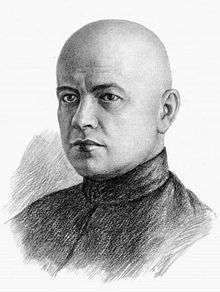 |
Stanislav Vikentevich Kosior | 30 May 1919 | 10 December 1919 | None | |
| - | Rafail Borisovich Farbman (acting) |
10 December 1919 | 23 March 1920 | None | ||
| 6 | Nikolai Ilyich Beschetvertnoi | 23 March 1920 | 25 March 1920 | None | 4 | |
| - |  |
Stanislav Vikentevich Kosior (temporary) |
25 March 1920 | 17 October 1922 | None | |
| 7 | 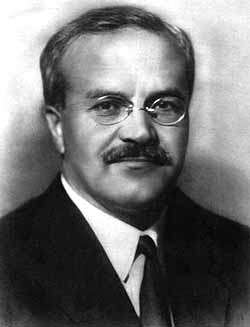 |
Vyacheslav Mikhailovich Molotov | 23 November 1920 | 22 March 1921 | Dmitriy Lebed | 5 |
| - |  |
Feliks Yakovlevich Kon (acting) |
22 March 1921 | 13 December 1921 | ||
| 8 | Dmitry Zakharovich Manuilsky | 14 December 1921 | 10 April 1923 | 6 | ||
| 9 |  |
Emanuil Ionovich Kviring | 10 April 1923 | 16 May 1924 | 7 | |
| 17 May 1924 | 7 April 1925 | Aleksei Medvedev | 8 | |||
| Ivan Klimenko | ||||||
| 10 | Lazar Moiseyevich Kaganovich | 7 April 1925 | 12 December 1925 | |||
| 12 December 1925 | 29 November 1927 | 9 | ||||
| Aleksei Medvedev | ||||||
| 29 November 1927 | 14 July 1928 | 10 | ||||
| 11 |  |
Stanislav Vikentevich Kosior | 14 July 1928 | 15 June 1930 | ||
| Lavrentiy Kartvelishvili | ||||||
| 15 June 1930 | 23 January 1934 | 11 | ||||
| Vasiliy Stroganov | ||||||
| Mendel Khatayevich | ||||||
| Pavel Postyshev | ||||||
| 23 January 1934 | 3 June 1937 | 12 | ||||
| Mendel Khatayevich | ||||||
| 3 June 1937 | 27 January 1938 | 13 | ||||
| Sergei Kudryavtsev | ||||||
| 12 | 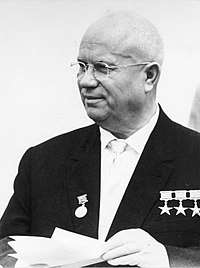 |
Nikita Sergeyevich Khrushchev (acting until 18 June 1938) |
27 January 1938 | 17 May 1940 | Mikhail Burmistenko (acting until 18 June 1938) | |
| 14 | ||||||
| 17 May 1940 | 3 March 1947 | 15 | ||||
| Demian Korotchenko | ||||||
| 13 | Lazar Moiseyevich Kaganovich | 3 March 1947 | 26 December 1947 | |||
| 14 |  |
Nikita Sergeyevich Khrushchev | 26 December 1947 | 28 January 1949 | Leonid Melnikov | |
| 28 January 1949 | 16 December 1949 | 16 | ||||
| 15 | Leonid Georgyevich Melnikov | 16 December 1949 | 27 September 1952 | Aleksei Kirichenko | ||
| 27 September 1952 | 4 June 1953 | 17 | ||||
| 16 | Aleksey Illarionovich Kirichenko | 4 June 1953 | 26 March 1954 | Nikolai Podgorny | ||
| 26 March 1954 | 21 January 1956 | 18 | ||||
| 21 January 1956 | 26 December 1957 | 19 | ||||
| 17 | 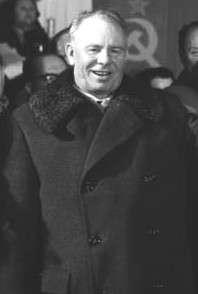 |
Nikolay Viktorovich Podgorny | 26 December 1957 | 19 February 1960 | Leontiy Naidek | |
| 19 February 1960 | 30 September 1961 | Ivan Kazaenets | 20 | |||
| 30 September 1961 | 2 July 1963 | 21 | ||||
| 18 | Pyotr Yefimovich Shelest | 2 July 1963 | 18 March 1966 | Nikolai Sobol | ||
| 18 March 1966 | 20 March 1971 | Aleksandr Lyashko | 22 | |||
| Ivan Lutak | ||||||
| 20 March 1971 | 25 May 1972 | 23 | ||||
| 19 | Vladimir Vasilyevich Shcherbitsky | 25 May 1972 | 13 February 1976 | |||
| 13 February 1976 | 12 February 1981 | Ivan Sokolov | 24 | |||
| 12 February 1981 | 8 February 1986 | 25 | ||||
| Aleksei Titarenko | ||||||
| 8 February 1986 | 28 September 1989 | 26 | ||||
| Vladimir Ivashko | ||||||
| 20 | Vladimir Antonovich Ivashko | 28 September 1989 | 23 June 1990 | Stanislav Gurenko | 27 | |
| 21 | Stanislav Ivanovich Gurenko | 23 June 1990 | 1 September 1991 | Leonid Kravchuk | 28 | |
| Grigoriy Kharchenko | ||||||
Party Congresses
There were 28 Congresses with the last one consisting out of two stages. There also were three consolidated conferences of the party from 1926 to 1932. At the second stage of the last Congress there were 273 members in the Central Committee.
First Congress, July 1918
This took place in Moscow and decided to call for preparations for an armed uprising against the occupying Central Powers forces and Hetman Pavlo Skoropadskyi’s dictatorship.[1] There were only 15 members in the Central Committee and six candidates.It reversed the decision adopted that April by a preliminary council in Tahanroh to established an independent Ukrainian bolshevik party with a membership in the envisaged Third International apart from the Russian party.
Central Committee
Ivan Amosov, Andrei Bubnov, Afanasiy Butsenko, Shulim Gruzman, Vladimir Zatonsky, Lavrentiy Kartvelishvili (excl.), Emmanuil Kviring, Stanislaw Kosior, Isaak Kreisberg, Yuriy Lutovinov, Georgiy Pyatakov, Rafail Farbman (excl.), Pinkhus Rovner, Leonid Tarskiy (Sokolovsky), Isaak Shvarts.
Promoted to members: Mikhail Mayorov (Meyer Biberman) and Pyotr Slinko
Second Congress, October 1918
This also took place in Moscow. Joseph Stalin was elected to the Central Committee.[2]
Central Committee
Artyom (Fyodor Sergeyev), Nikolai Beschetvertnoi, Shulim Gruzman
Third Congress, March 1919
This congress took place in Kharkov. A new central committee with a majority of Left Communists was elected. This prompted the Eight Congress of the Russian Communist Party to pass the following motion: ""It is necessary to have a unified communist party with a unified central committee ... All decisions of the RCP and its leading organs are absolutely binding for all parts of the party, independent of their national composition. The central committees of the Ukrainian, Lettish and Lithuanian communists are conferred the rights of regional committees of the party; they are to be unreservedly subordinate to the central committee of the RCP."[3]
Fourth Congress, March 17–23, 1920
The Borotbists were forced to dissolve themselves and their erstwile members were permitted to join the CP(b)U.[4] Vasyl Ellan-Blakytny and Shumsky drawn from the Borotbist leadership were elected to the Committee and the Borotbist Central Committee passed a resolution dissolving the Borotbist party and its central committee. All members were instructed to apply for CP(B)U membership. Nearly 4,000 out of approximately 5,000 Borotbists were admitted to the CP(B)U.[5]
Later congresses
From 1919 to 1934 all meetings were conducted in Kharkiv, capital of the Ukrainian SSR.
There were three major Committees and several Bureaus. Each committee had members and candidates to members each with certain degree of obligations. The members and candidates to the committees were elected at the Party Congress. The number of members varied from one gathering to the next usually in ascending sequence. During the Great Purge the numbers remarkably declined as well as one of the committees, Central Control Committee, was disbanded. The first members were elected in 1918, 15 members of the Central Committee, six candidates as well as three members and two candidates of the Revision Committee. In 1920 the Central Control Committee was formed and by 1934 the Party accounted for some 191 members and 45 candidates in all committees. In 1937 there were only 71 members and 40 candidates in two committees. By 1990 the number of members grew just over 300 members.
Party headquarters
| Years | Photo | Building | Remarks |
|---|---|---|---|
| 1922 – 1934 | 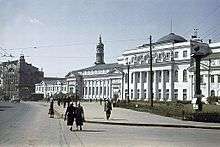 | Building of Noble Assembly, Kharkiv | |
| 1934 – 1938 | | Security Service of Ukraine building, Kiev | |
| 1938 – 1941 |  | Building of Ministry of Foreign Affairs, Kiev | |
| 1943 – 1991 |  | Presidential Administration Building (Kiev) |
Party newspapers
Central newspapers
- Pravda Ukrainy (Sovetskaya Ukraina[6] 1938–1943, Pravda Ukrainy[7] 1944–1991), Russian language newspaper
- Radyanska Ukrayina (Kommunist 1918–1926, Komunist 1926–1943, Radyanska Ukrayina 1944–1991), Ukrainian language newspaper
- Silski Visti (1920–1991)
- Ukrayina Moloda (1991)
Regional newspapers
- Bilshovyk Poltavshchyny (1917-1941)
See also
- First Secretary of the Communist Party of Ukraine
- Handbook on history of the Communist Party and the Soviet Union 1898–1991
- Institute of History of the Party
References
- ↑ accessed 24 January 2011
- ↑ Joseph Stalin, Biographical Chronicle Archived 2011-05-24 at the Wayback Machine. accessed 24 January 2011
- ↑ The Self-Determination of Nations: The Theory and Practice (Ukraine and Georgia) by Annette Franz and Dave Hollis accessed 24 January 2011
- ↑ Draft Resolution on the Ukrainian Borotbist Party (Notes) accessed 24 January 2011
- ↑ A great experiment`; Towards the history of national communism in Ukraine By James Mace, accessed 24 January 2011
- ↑ Sovetskaya Ukraina. Old newspapers.
- ↑ Pravda Ukrainy. Old newspapers.
Further reading
- J. Borys, The Sovietization of Ukraine 1917-1923 : the Communist doctrine and practice of national self-determination (1980)
- A. Adams, Bolsheviks in the Ukraine (1963)
External links
- Dmitricheva, O., Rakhmanin, S. Ukraine partisan. Part IV. Communist. Mirror Weekly. 1 March 2002.
